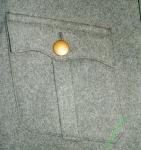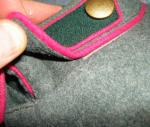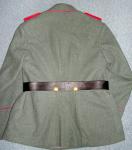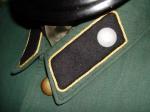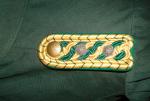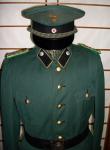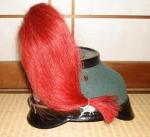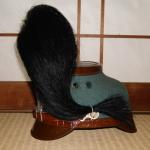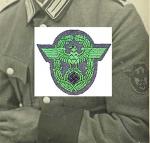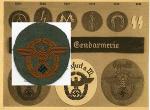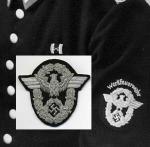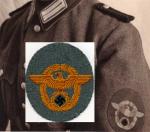-
Posts
344 -
Joined
-
Last visited
-
Days Won
1
Content Type
Profiles
Forums
Blogs
Gallery
Events
Store
Everything posted by W.Unland
-
A closer view of the front showing the typical "hidden" button closure. These tunics had a color scheme unique in German tunics. It incorporated gold , green, and carmine, all on the same uniform. Very unusual, particularly the shoulder boards. Also notice how the boards sit in the "middle" of the shoulders and not along the sleeve seam......very unusual.
-
Hello, A rather rarely seen tunic is presented, that of a Justice official in pre-1942 configuration. Prior to 1942 Justice officials/court baliffs wore "Justice" green tunics with carmine piping, hidden front buttons and gold fittings. The cap shown with the tunic is that worn after 1942 by both Justice and Prison officials. In 1942 the carmine piping was dropped and both used green piping. The cap band is black. The pre-1942 cap would have had carmine piping. Unfortunately these have all been converted by dealers into Waffen SS piped panzer schirmmutzen, so the chances of finding one in original condition are next to nothing. This tunic was worn with black breeches or trousers. These tunics are unique in that NO sleeve eagle, arm band or any other "national" emblem was worn on the tunic. It is the ONLY TR period government official's tunic that I am aware of that did not incorporate any eagles or swastikas into the insignia (other than the small cap eagle and belt buckle).
-
And lastly a view of the collar tabs. Although regulations call for gold stripes down the center it seems that these "plain" tabs were utilized for all enlisted ranks. I have only seen photos of one early tunic that actually had the added braid stripes to designate rank. These tabs are found in both black as shown here, and in dark green. Regards, WIlliam Unland
-
Here is a closer view showing the cap with it's distinctive chincord and black band. Unfortunately these hats have all but disappeared as they are "converted" to waffen SS to make more money, even though "Justice" green is NOT the same as field gray, and the piping is NOT the correct green they try to pass them off as rare piped W-SS. This cap has two prison property stamps in its interior.
-
Hello, Here is presented a rather rare to see prison guard's uniform that complies with the 1942 regulations. Prior to 1942 these tunics had concealed buttons down the front and the pocket and board buttons were silver. The collar tabs are piped in gold cellulon and the boards are green and gold. After 1942 both prison and Justice officials wore the same insignia, with the exception of prison retaining the silver tab button, while justice wore gold. Prior to 1942 Justice officials wore carmine piping and boards as shown in my other thread detailing such a uniform. Black trousers or breeches were worn, and the cap band is also black. This particular example is a summer blouse in a heavy cotton fabric, unpiped, and unlined. Quite practical for wear in a prison.
-
Hello, These were the three colors used from 1936 on. There was also a red buffalo hair for "senior" musician nco's, but basically these were the three "bush" used by the police. I don't think any othr branch of government continued the practice of tschakos and parade bush except the police. As was pointed out to me, general officers wore a black and white rooster feather plume for a very short time during the TR period, but this was a hold over fom imperial times and I have never seen one, nor a photo of one. Regards, Bill Unland
-
Hello, We all know that the police wore parade plumes or "bush" on their Tschakos when in full dress. I think some not so obsessed by police collecting might NOT be aware that there were THREE colors of plumes. As shown in this photo, the standard enlisted man, from all branches wore a black horsehair plume. Officers a white buffalo hair plume. And the one you don't see too often, musicians wore a RED horsehair plume. (not quite as "bozo" red as the flash photo appears) The officer's buffalo hair plumes are much much finer hair. Much more "glossy" befitting the generally higher quality of their tschakos.
-

Cloth police eagle
W.Unland replied to Michael's topic in Germany: Third Reich: Uniforms, Headwear, Insignia & Equipment
Hello, This eagle is an original. It is one of a reported group of 100 that was recently released onto the market. Apparently a vet was holding onto bundles of these, or at least that is the story. These can be found for sale on most dealer's sites at present. They are all identical late war eagles in unused condition as shown above. Regards, William Unland



